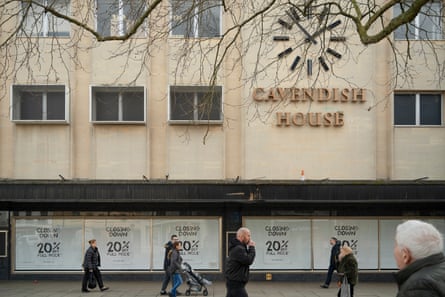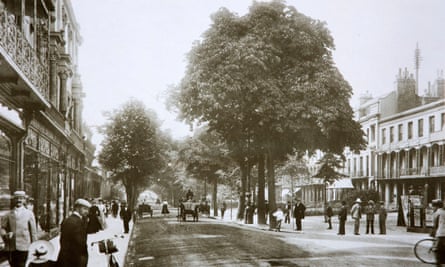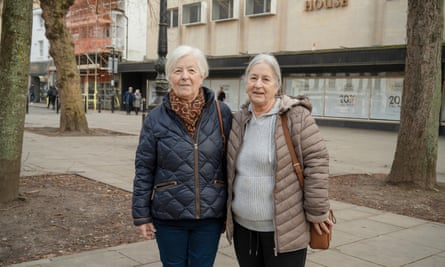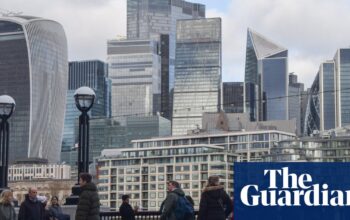If you were interested in examining the challenges faced by retail stores in Britain, Cheltenham may not be the most obvious location to begin with. There are no closed shops or deserted roads, and there is not an excessive number of betting shops or charity stores. Additionally, stores with “pound” in their names are not noticeably prevalent.
However, the vibrant streets of the charming town center are full of activity and it appears that business is stable, if not thriving. Therefore, it is not difficult to imagine, on a sunny Wednesday afternoon, that everything is going well in the world – or at least in this affluent area of Gloucestershire.
With the exception of the “closing down” sale signs adorning the front of Cavendish House, a department store that has stood as a retail icon in Cheltenham for 200 years. Situated in a prime location on the sophisticated Promenade, the store was a symbol and popular destination for affluent locals for many generations. However, it will permanently shut its doors in April.
Kate Ashby, who worked in the accounts department at the shop in the 1960s along with her sister Rose, recalls it as a charming establishment. The shop boasted a hair salon, a delightful food hall, elegant wooden floors, and stunning window displays. During that time, there were clear hierarchies for both staff and customers, and the shop prided itself on providing personalized customer service, which was playfully satirized in the 1970s sitcom Are You Being Served?.

Rose mentions that the store was quite pricey and many individuals had accounts there. Additionally, there was a lovely restaurant located on the second level of the store.
However, with the breakdown of social structures during that time, several department stores have struggled to adapt and transform themselves. If one were to visit Cavendish House presently, it would appear somber and dim.
According to Mary Portas, a broadcaster and retail consultant, traditional department stores are now referred to as “big mausoleums of stuff” and have not been successful in differentiating themselves. While some stores like Selfridges and Liberty have succeeded by creating targeted and unique shopping experiences, many others have struggled due to a lack of creativity and focus, leading them into a downward trend.
In Cheltenham, many believe that the downfall of Cavendish House can be attributed to wealthy entrepreneur Mike Ashley. In 2018, Ashley purchased the parent company, House of Fraser, and the same year saw the opening of a John Lewis store nearby. Ashley is not held in high regard in the town, much like how he was viewed in Newcastle when he owned the local football club. However, House of Fraser was already facing financial troubles when Ashley took over, and he has successfully revived the company’s success through his renamed and profitable Frasers Group, which includes Sports Direct and Jack Wills clothing brand.

Portas states that it is simply intelligent individuals effectively managing profits and financial figures, but in doing so, they are sacrificing the value and significance of the brand to consumers.
She holds the belief that in order for the main street to regain its uniqueness and objective, companies must consider their broader societal influence and what they contribute to a community, rather than solely focusing on what they can gain.
Sharon Williams, a retail worker, expresses sadness about the closure of Cavendish House, a department store, like many others who pass by the establishment. Despite no longer being a customer herself, she feels a sense of loss.
Feeling sorrow over the end of something does not necessarily mean wanting it to continue existing. It is likely accurate to state that a lot of individuals experience nostalgia, insincerity, and lack of effort in their modern shopping encounters.

Display the image in full screen mode.
Who doesn’t feel sad when a beloved local shop closes down, while we sit comfortably in our armchairs and search for online deals that are not affected by commercial rent and rates?
According to Portas, the rise of online commerce has been the most significant change in our lifestyle and shopping habits in the 21st century. While it has had a negative impact on traditional brick-and-mortar stores, resulting in a struggle for survival for many, it has also eliminated some of the generic chain stores that have homogenized high streets.
According to her, these chains did not have any loyalty towards the towns they left. They lacked a sense of belonging or uniqueness. These are the characteristics that main streets should strive to regain.

According to Portas, there is reason to be hopeful because ultra-consumerism, which focused on buying inexpensive clothing without regard for its impact on the environment, is dying out. The new trend is centered around recycling, upcycling, buying vintage items, and making more thoughtful purchasing choices. This change in consumer behavior has been accelerated by the current cost of living crisis.
She envisioned a department store that had a floor specifically for vintage and second-hand clothing, as well as one dedicated to vinyl records and music. Another floor would be designated for childcare services and restaurants where parents could leave their children. She believes that these businesses are in need of more creativity and fresh ideas.
When individuals are asked about their desired establishments on a busy street, they usually include hardware stores and fish markets. The scarcity of these types of shops can be attributed to their high costs. The typical yearly rent for a retail space in the UK is approximately £25 per square foot, although prime locations can cost up to 10 times that amount. Additionally, business rates typically make up half of the rental cost. Therefore, a medium-sized store may have to spend £75,000 before considering expenses like employee salaries. This amount is equivalent to a significant number of shrimps and screws.
Updating the commercial rates system and implementing rent control could be beneficial if it prioritized the needs of the community and punished excessive numbers of real estate agents on a single street.
Department stores, which once aimed to sell everything, were an economy-of-scale answer to individual shops. But research suggests that nowadays we want a more bespoke shopping experience. That accounts for the rise of artisanal food shops and local farmers’ markets.
According to Alexandra Shulman, ex-editor of British Vogue, the combination of these alterations with a heightened awareness of the environmental impact of driving to suburban shopping centers and the downfall of various online fashion companies, is leading to a movement towards the traditional concept of a bustling main street. This idea demands creativity and vision, along with assistance from local government and effective planning.
Alex Chalk, MP for Cheltenham, advocates for the transformation of Cavendish House into a diverse development that includes a combination of retail spaces, recreational facilities, and high-quality accommodation in the town centre.
Portas suggests that the formula could have various interpretations, but by taking into account the desires and necessities of the community, the likelihood of accurately understanding it would greatly increase.
Source: theguardian.com


